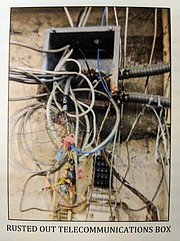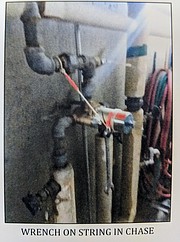Shoshone County Jail gets put under the microscope
By CHANSE WATSON
Managing Editor
WALLACE — It has been said that in order to improve yourself, you must first identify your shortcomings or flaws.
This is the approach Shoshone County Sheriff Mike Gunderson is taking when it comes to making his case to the public for a new jail and facility.
On Friday, representatives with Performance Leadership Institute Inc. presented an assessment of the jail to SCSO and county leadership at the courthouse in Wallace.
PLI Inc., a Coeur d’Alene-based law enforcement contractor, was hired by SCSO in 2018 to conduct a top-to-bottom inspection of the current jail building and identify both it’s strengths and weaknesses.
The decision by Sheriff Gunderson to explore the idea of a new building was spurred by his assessment of the building’s aging and obsolete infrastructure.
“Our facility is getting outdated,” Gunderson explained in an earlier interview. “Between the standards for keeping jail certification and keeping up with a changing society, it’s difficult.”
Originally built in the 1970s as a used car lot, the repurposed SCSO building and jail is much smaller in comparison to neighboring facilities (such as the Kootenai County Jail) and lacks several modern upgrades.
The nearly 40-page report, presented by Kootenai County Sheriff Ben Wolfinger and PLI Inc. President April Lee, largely backed up what Gunderson and the rest of the SCSO personnel have said.
Wolfinger has 35 years of law enforcement experience and is well-versed in constructing and operating a jail. As the Kootenai County Sheriff, he currently runs a 451-bed jail and was successful in getting a large addition to his facility approved after 10 years.
Lee has 20 years of law enforcement experience and has worked with many different agencies on a variety of projects including marketing, community awareness, social media, organizational development and much more.
The beginning of the presentation featured Wolfinger pointing out one of the few positive items he noticed during the inspection, but the good news did not last long.
“When I walk into the jail, it’s one of the cleanest jails I have been in. It doesn’t smell like a lot of jails. That’s a compliment to the staff!” he said. “Then you get below the surface and its like, ‘holy moly we’ve got problems here.”
Wolfinger would spend the next 30 minutes talking about the community and detailing several glaring deficiencies PLI Inc. noticed during their inspection — many of which relate back to the building’s decrepit state and outdated design.
“You’ve got pipe problems that are astronomical. When I see sewer pipes that are rusting on the outside from leaks, that’s a problem. When I see electrical boxes that are literally rusted away because of outside water coming through the conduits and masses of wire (nobody knows what’s hot and what’s not), that’s a problem.”
In the section of the report detailing the facility itself, the structural problems were numerous.
“Many of the pipes leak where they pass through concrete floors and are basically inaccessible unless a cell block is emptied and the workers are allowed to break out the concrete floor to access the pipes,” the assessment read. “It was even found that in one of the chases between cell blocks, there was a box wrench tied with string so staff would have a wrench available to shut off a valve.”
As if the many leaks were not already a huge issue themselves, the water escaping from the pipes and the floor create additional problems.
For example, the report details an unsecured records storage area and maintenance room as being plagued by water damage.
“In this room, a small stream of water was observed running across the floor towards a floor drain and sump. Records are stored in file cabinets and banker boxes in one portion of the room. Also in the room, covered with a tarp, are antique books and records for the Sheriff’s Office…Due to the many different leaking pipes, these books and records must remain covered (with tarps) to protect them.”
The leaking water ironically poses a fire risk to the building, as electrical conduits and power boxes are consistently dripped on. Sometimes the people in the building are even lucky that it’s just water leaking most of the time.
“The staff described sewer leaks that had leaked onto heating ducts and filled the entire office with the odor of warm sewage,” the report read. “Evidence of previous pipe leaks was obvious in many different locations.”
These discoveries alone had Wolfinger scratching his head.
“How you haven’t had an electrical fire in there, I don’t know. I’m surprised the health department hasn’t come in and said, ‘you’re done.”
As for layout and design, the roughly 40-year-old repurposed building has not aged well when compared to modern facilities or held to modern health codes.
The jail portion of the Sheriff’s Office itself is made up of six blocks all connected by a “very linear” and snug main north-south hallway.
“Upon entry to the main hall of the jail property, it was noted that the hall was noticeably narrow, only being 60 inches wide,” the report states. “The main north-south hallway is narrow to the point that it would be difficult for two deputies to escort an inmate down the hall.”
On top of the deficiencies with what is present, the facility has no suitable cells for certain individuals, such as transgender inmates, mentally ill inmates, juveniles and sex offenders.
For the deputies and staff the building has no employee locker room, lacks separate employee male and female restrooms, has no interview room, limited office space and dwindling evidence storage space.
With all of these issues on the table, Wolfinger advised against a refurbishment and detailed out PLI’s recommendations, which consisted of a 10-step process to eventually building a new jail.
After the presentation, Gunderson told the News-Press that he thinks their findings were spot on.
“I think it just reiterates what we have been saying. We need to look towards the future or a couple of things are going to happen. We are going to grow out of our current facility, being that we are housing 36 to 42 local inmates (on average currently) and our capacity is only 48.”
If SCSO continues to push for a new facility, the plan is to have a bond proposal on the ballot this November.
Specific costs or designs have not been discussed at this time, but Gunderson strongly believes that with an increase in the number of open beds and cells a new facility would bring, it would open up a new line of revenue for the county.
“One of the things the assessment does bring out is with building a facility, we can generate revenue for the taxpayers of Shoshone County.”
Gunderson plans to make an agreement with The Idaho Department of Corrections that would allocate a certain number of beds to state and federal inmates. This deal would bring in $75 per bed to the county, regardless of if the bed was being filled or not.
A location for the new facility has also not been decided on, but county law states that the jail must be in the county seat — which is Wallace. Both SCSO and the county have been looking at land north of the interstate along North Frontage Road as a possible home.
For those who wish to see the full jail assessment, a copy can be obtained from the Shoshone County Sheriff’s Office or the Shoshone County Board of County Commissioners in the courthouse.







